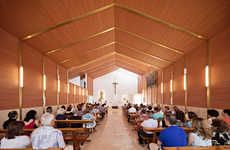



Educational infrastructure is designed with net-zero energy outputs
Trend - As an educational institution's ability to attract top talent remains a marker of its overall success, an increasing number of schools and research facilities are investing in building net-zero infrastructure. This shift serves as a reflection of the forward-facing values that many students and intellectuals across disciplines have surrounding sustainability.
Insight - The average young person today understands the urgency of climate change more than their predecessors, in-part because they're more likely to be affected by the consequences it's projected to have on the world. Younger demographics expect that brands, institutions and governments act quickly in order to mitigate the risks associated with changing temperatures globally.
Insight - The average young person today understands the urgency of climate change more than their predecessors, in-part because they're more likely to be affected by the consequences it's projected to have on the world. Younger demographics expect that brands, institutions and governments act quickly in order to mitigate the risks associated with changing temperatures globally.
Workshop Question - Consider the infrastructure your organization relies on. What underlying message is it sending to your target audience?
Trend Themes
1. Net-zero Infrastructure for Institutions - As institutions compete to attract top talent, building net-zero infrastructure is increasingly seen as a reflection of forward-facing values that students and faculty have surrounding sustainability.
2. Growing Demand for Sustainable Construction Materials - Timber, a sustainable material, is growing in popularity among architects and engineers as demonstrated by the timber building 'The Arbour' and the use of an edible forest at the wetland research center 'El Humidal'.
3. Innovative Sustainable Building Designs - Serie Architects & Multiply Architects and Moriyama & Teshima Architects and Acton Ostry Architects are among firms producing innovative sustainable building designs, including the net-zero energy academic building 'The Emma and Georgina Bloomberg Center'.
Industry Implications
1. Education - Institutions that build net-zero infrastructure may have an advantage in attracting top talent as younger demographics expect brands, institutions, and governments to act quickly to address climate change and mitigate associated risks.
2. Construction and Engineering - Growing demand for sustainable materials such as timber presents an opportunity for construction and engineering firms to invest in sustainable innovation.
3. Architecture and Design - The need for innovative sustainable building designs continues to grow as more industries, including education, healthcare, and hospitality, prioritize sustainability for their stakeholders.
4 Featured, 34 Examples:
113,286 Total Clicks
Date Range:
Feb 18 — Mar 19
Trending:
Average
Consumer Insight Topics:





































